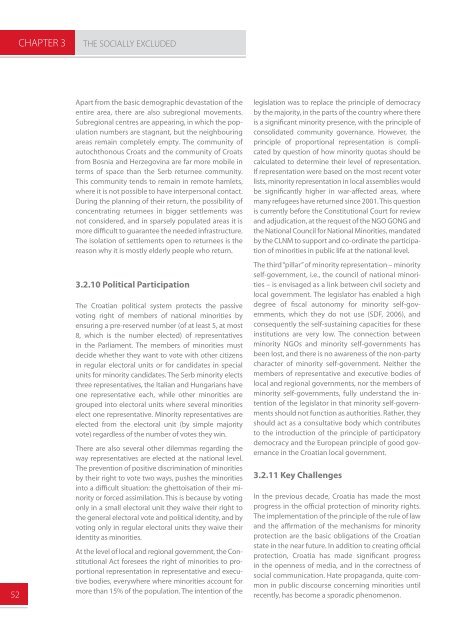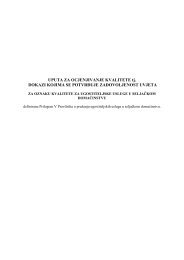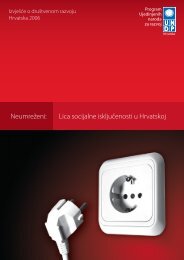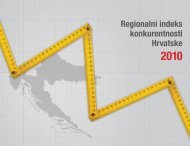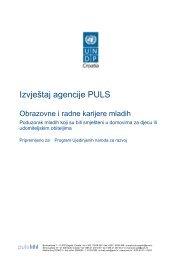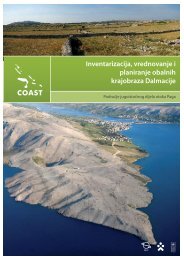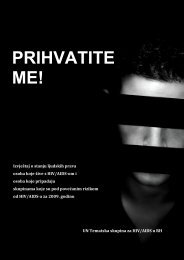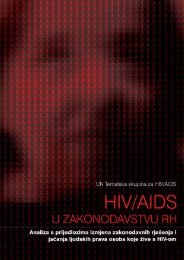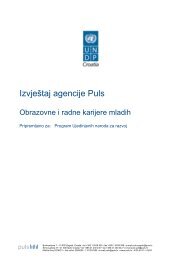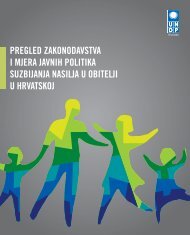WEB engleska verzija end.indd - UNDP Croatia
WEB engleska verzija end.indd - UNDP Croatia
WEB engleska verzija end.indd - UNDP Croatia
- No tags were found...
You also want an ePaper? Increase the reach of your titles
YUMPU automatically turns print PDFs into web optimized ePapers that Google loves.
CHAPTER 3THE SOCIALLY EXCLUDED52Apart from the basic demographic devastation of theentire area, there are also subregional movements.Subregional centres are appearing, in which the populationnumbers are stagnant, but the neighbouringareas remain completely empty. The community ofautochthonous Croats and the community of Croatsfrom Bosnia and Herzegovina are far more mobile interms of space than the Serb returnee community.This community t<strong>end</strong>s to remain in remote hamlets,where it is not possible to have interpersonal contact.During the planning of their return, the possibility ofconcentrating returnees in bigger settlements wasnot considered, and in sparsely populated areas it ismore difficult to guarantee the needed infrastructure.The isolation of settlements open to returnees is thereason why it is mostly elderly people who return.3.2.10 Political ParticipationThe <strong>Croatia</strong>n political system protects the passivevoting right of members of national minorities byensuring a pre-reserved number (of at least 5, at most8, which is the number elected) of representativesin the Parliament. The members of minorities mustdecide whether they want to vote with other citizensin regular electoral units or for candidates in specialunits for minority candidates. The Serb minority electsthree representatives, the Italian and Hungarians haveone representative each, while other minorities aregrouped into electoral units where several minoritieselect one representative. Minority representatives areelected from the electoral unit (by simple majorityvote) regardless of the number of votes they win.There are also several other dilemmas regarding theway representatives are elected at the national level.The prevention of positive discrimination of minoritiesby their right to vote two ways, pushes the minoritiesinto a difficult situation: the ghettoisation of their minorityor forced assimilation. This is because by votingonly in a small electoral unit they waive their right tothe general electoral vote and political identity, and byvoting only in regular electoral units they waive theiridentity as minorities.At the level of local and regional government, the ConstitutionalAct foresees the right of minorities to proportionalrepresentation in representative and executivebodies, everywhere where minorities account formore than 15% of the population. The intention of thelegislation was to replace the principle of democracyby the majority, in the parts of the country where thereis a significant minority presence, with the principle ofconsolidated community governance. However, theprinciple of proportional representation is complicatedby question of how minority quotas should becalculated to determine their level of representation.If representation were based on the most recent voterlists, minority representation in local assemblies wouldbe significantly higher in war-affected areas, wheremany refugees have returned since 2001. This questionis currently before the Constitutional Court for reviewand adjudication, at the request of the NGO GONG andthe National Council for National Minorities, mandatedby the CLNM to support and co-ordinate the participationof minorities in public life at the national level.The third “pillar” of minority representation – minorityself-government, i.e., the council of national minorities– is envisaged as a link between civil society andlocal government. The legislator has enabled a highdegree of fiscal autonomy for minority self-governments,which they do not use (SDF, 2006), andconsequently the self-sustaining capacities for theseinstitutions are very low. The connection betweenminority NGOs and minority self-governments hasbeen lost, and there is no awareness of the non-partycharacter of minority self-government. Neither themembers of representative and executive bodies oflocal and regional governments, nor the members ofminority self-governments, fully understand the intentionof the legislator in that minority self-governmentsshould not function as authorities. Rather, theyshould act as a consultative body which contributesto the introduction of the principle of participatorydemocracy and the European principle of good governancein the <strong>Croatia</strong>n local government.3.2.11 Key ChallengesIn the previous decade, <strong>Croatia</strong> has made the mostprogress in the official protection of minority rights.The implementation of the principle of the rule of lawand the affirmation of the mechanisms for minorityprotection are the basic obligations of the <strong>Croatia</strong>nstate in the near future. In addition to creating officialprotection, <strong>Croatia</strong> has made significant progressin the openness of media, and in the correctness ofsocial communication. Hate propaganda, quite commonin public discourse concerning minorities untilrecently, has become a sporadic phenomenon.


